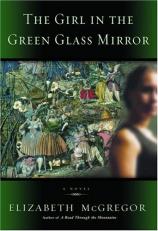Reading Group Guide
Discussion Questions
The Girl in the Green Glass Mirror

With The Girl in the Green Glass Mirror, acclaimed novelist Elizabeth McGregor has crafted both a mesmerizing love story and an unforgettable portrait of one of Britain's most intriguing nineteenth-century painters. At the center of this tale are Catherine Sargeant, an antiques dealer whose husband has deserted her silently and suddenly, and John Brigham, a widowed architect who has become a new client of Catherine's. Awakening from deep loneliness, Catherine and John soon discover that their intense attraction to each other is matched by a subtle current of secrecy–including one secret whose value may be priceless. The mysteries revolve around Richard Dadd, an early Victorian painter who spent most of his life in England's notorious Bedlam asylum, where he produced stunning works that continue to fascinate collectors today.
Deftly weaving scenes of the contemporary art world with haunting chapters from history, McGregor gives us a novel of passion and possession, love and legacy. The questions and discussion topics that follow are intended to enhance your reading of Elizabeth McGregor's The Girl in the Green Glass Mirror. We hope they will enrich your experience of this breathtaking novel.
1. What is the effect of the novel's prologue? Besides Richard Dadd, which of the novel's other characters experience exile?
2. How would you characterize Catherine and Robert's marriage? What drew them together? In your opinion, what is the true reason for Robert's departure?
3. How have Catherine and John each experienced love in the past? What enables them to begin to trust one another?
4. In what ways do art and architecture resonate with Catherine and John? Do they share a similar philosophy regarding the material world? Would John have kept the Dadd paintings for such a long time if they hadn’t been part of his family history?
5. What do Dadd's paintings indicate about his perception of the world? What do you visualize when you read Elizabeth McGregor's descriptions of them?
6.
6. Discuss the book's title. Whose reflections do you believe appeared to the fictional Dadd? Was he seeing the future, or were the novel's contemporary characters imposing their own understanding of the past onto these images? What were your reactions to the use of photographs in "treating" the patients at the asylum? Do visual images capture reality?
7. Toward the end of Chapter Seven, John has a chance encounter with the architect Soane's house. Why is this such a disturbing encounter for him? What does it express about the nature of his love and grief for Claire?
8. How do you account for the differences between John and his sister, Helen? How do contemporary approaches to mental illness differ from those of the nineteenth century?
8. What does "The Fairy Feller's Master Stroke" express about the nature of rage as well as the nature of creativity? Does it differ from the imagery in "The Child’s Problem?" What makes them intriguing objects to John and Catherine?
9. In Chapter Seventeen, Mr. Williams ends his life. What had Catherine learned about her profession, and about human nature, from her interactions with him? Does this incident make John more or less inclined to trust her with "every priceless secret thing he had been entrusted with," as the last line of this chapter phrases it?
10. Researching the life of Richard Dadd makes for a fascinating supplement to the novel. Having begun his artistic career at age thirteen, he was accepted into the prestigious Royal Academy by the time he was twenty. His professors there commented on his gentleness and artistic promise, but in his mid-twenties he lost his sanity and became homicidal. Paired with the contemporary love story presented in The Girl in the Green Glass Mirror, what elements of tragedy and rebirth emerge?
11. Dadd arrives at Broadmoor at the end of Chapter Twenty-one feeling deeply unsettled and believing that "the real world, a thing of beauty, had to be guarded . . . shut up firmly against its parody." What significance do these lines have for Catherine and John at this point in the novel, as John's health worsens and Helen's jealousy is reaching a crescendo?
12. At the end of Chapter Twenty-five, Dadd paints his muse. What other muses appear in the novel? Who have been your muses, either in creativity or in other aspects of your life?
13. How has Catherine's understanding of love been transformed by the time of the novel's postscript?
15. McGregor's previous novel, A Road Through the Mountains, is also set in the art world and features a talented painter whose past secrets come to light after she is injured in a tragic accident. In what way does visual art create an enticing backdrop for exploring the lives of characters in a novel? What perspectives on fate and self-fulfillment do these two works offer?
16. Discuss any artifacts that have been handed down in your family. What significance do these items possess for you? What connections to your ancestry and personal history do they provide?
The Girl in the Green Glass Mirror
- Publication Date: July 26, 2005
- Hardcover: 320 pages
- Publisher: Bantam
- ISBN-10: 055380359X
- ISBN-13: 9780553803594







